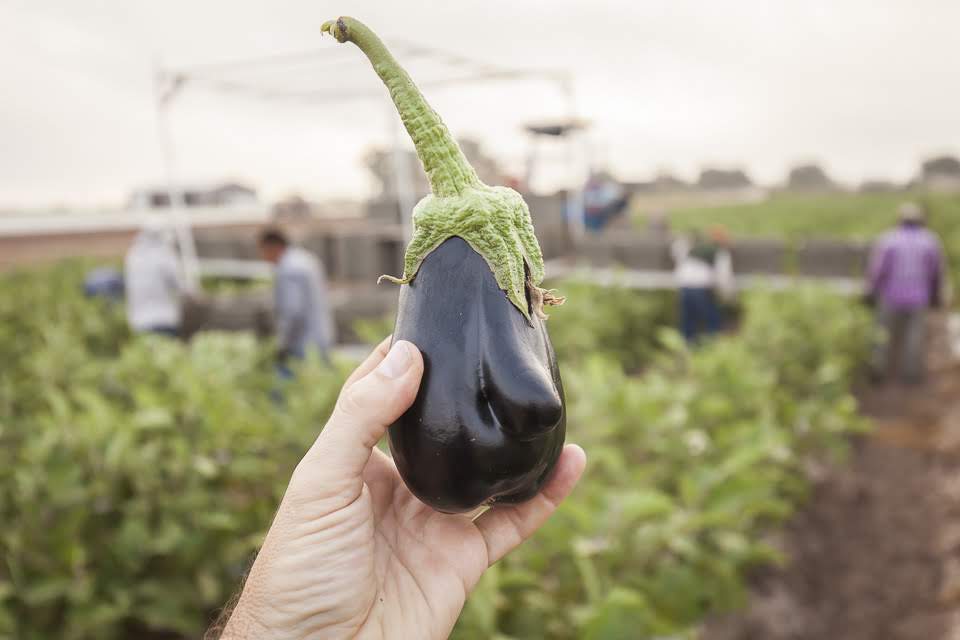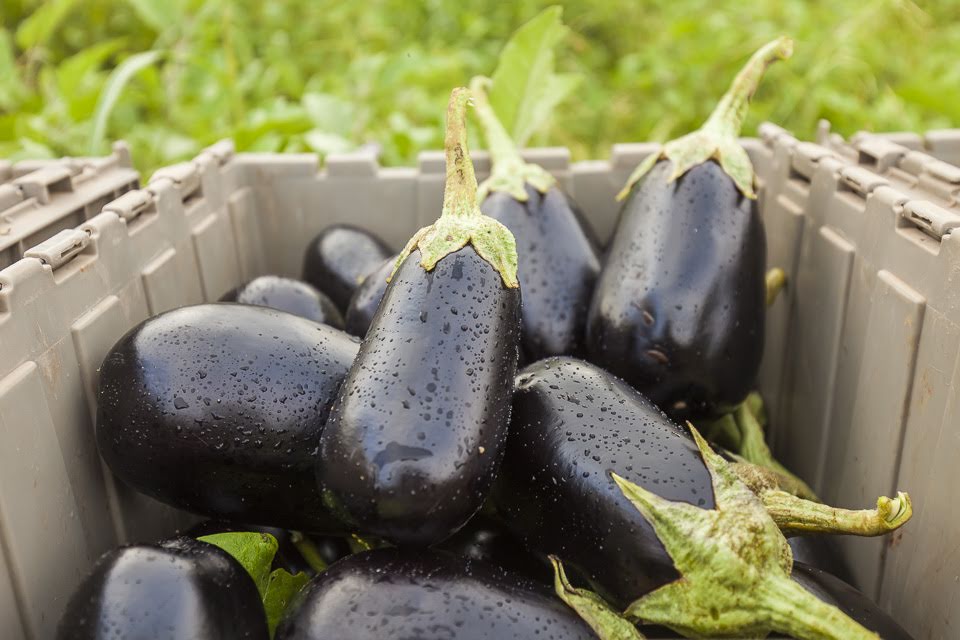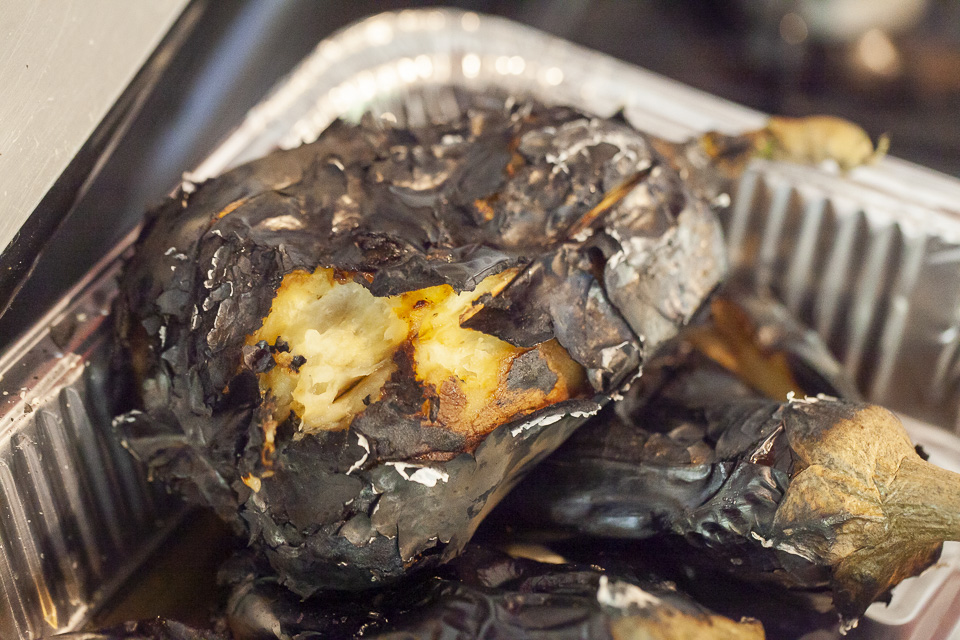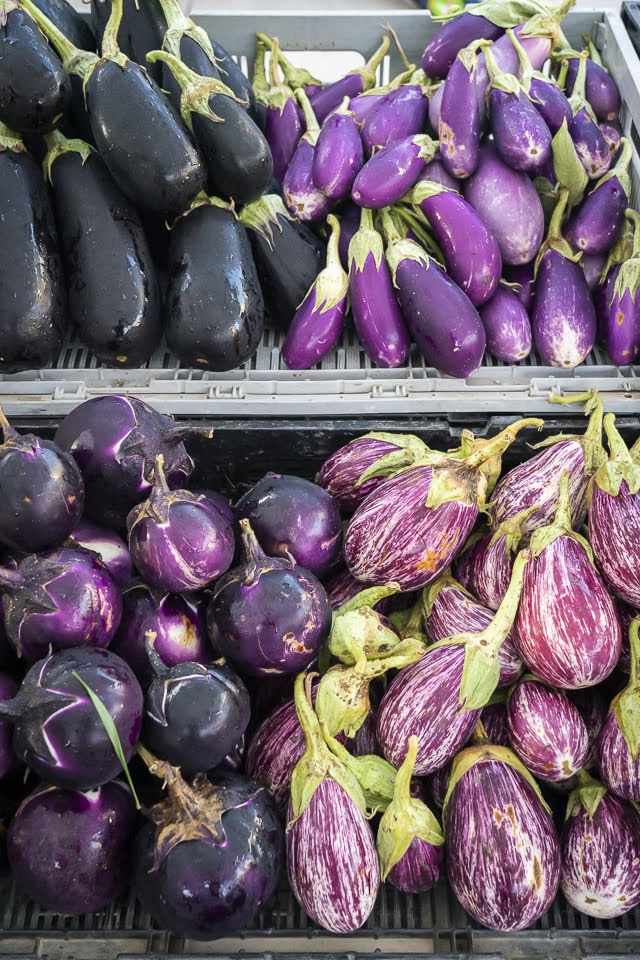
A CASE FOR EGGPLANT
07/02/21 — Ada Broussard

There comes a time each summer when the eggplant harvests start to roll in. If all things go to plan, this purple wave doesn’t really ebb until September, and when considering extreme temperatures that reign over the farm during the summer, all the eggplant should make sense: in addition to okra and peppers, eggplant is a heat-loving… ni, heat-thriving. While crops like tomatoes, cucumbers, and even our summer greens can tuker out under the pressure of 100 degree days, eggplant can take it. But can you?
For many, eggplant is a big spongy question mark. Like a potato, eggplant can’t really be consumed raw, and perhaps it's the necessity to cook the thing that makes it feel inaccessible. Or maybe it’s the slight bitterness that turns you off. Of all the vegetables we grow on the farm, eggplant is perhaps the one that’s most often ‘swapped out’ in our CSA program, and even us farmers are guilty of harboring a wrinkly, soft eggplant at the bottom of our crisper drawer, destined for the compost. Today’s post isn’t the first time we’ve tried to play matchmaker between this unique vegetable and you, our wonderful farm community.

But, whether you like it or not, eggplant is here to stay. Today, we’re here to make a case for this versatile vegetable, botanically a berry. Cuisines across the world welcome the aubergine to the table, and we think with a little convincing, you can too. Many of the recipes we’re linking to today come from YouTube which just so happens to be a rich source of global recipes - a platform where home cooks across the world can share their grandma's best version of eggplant delight.
While a yellow squash is kinda like a zucchini, and we encourage you to seasonally substitute cool-weather parsley for warm-loving basil, is there anything just like eggplant? Perhaps its most meritorious quality is its ability to soak up whatever flavors it encounters, its spongy flesh becoming silky smooth when roasted or fried, or becoming a flavor bomb when braised in liquid or a stew.

A Few Eggplant tips:
Should I peel eggplant: Eggplant skin is completely edible, though the larger the eggplant, the tougher the skin. Generally, we like to peel large varieties of eggplant, and keep the skin on the smaller, tender varieties.
Should I salt the eggplant? Salting eggplant is a well-known trick to removing its sometimes bitter flavor. Salt cut eggplant either by soaking in a very salty bowl of water, or by simply salting the flesh and placing over a colander. Though most of the varieties we grow at JBG are less bitter, things like daily temperatures and even our watering schedule can affect the taste of eggplant. If you’re worried about bitterness, you might as well salt. Before cooking, make sure to either wipe off or rinse and pat dry
What should I do with eggplant?
Braise it.
Braising, or searing something and then cooking it in a bit of liquid, is a wonderful choice for eggplant because of its porous nature. Stewed or braised eggplant can be rather ‘meaty’, and whether you’re substituting it for meat entirely or preparing it alongside, the most important thing here is to make sure you are surrounding it with something delicious. Here is a wonderful Youtube video for a Chinese Mapo Eggplant recipe, a perfect main dish when spooned over rice. If you want to devote yourself to rekindling your eggplant relationship, might we suggest this somewhat labor-insensitive, but wholly worthwhile, Persian stew called khoresh bademjan. In this savory pot of onions, tomatoes, lamb and spices, eggplant is first fried till the flesh turns carmel-colored, then simmered. Or, you can make this Japanese shoyu recipe in which eggplant is scored, and then simply braised in dashi (similar to a stock), soy sauce, and a few other other ingredients. In this recipe video for Thai Eggplant Curry, tiny eggplants are smashed and then braised, and we can’t help but think of all that added surface area soaking up the rich coconut-based sauce. You may not be able to easily get fresh pandan leaves or jackfruit seeds for this specific curry recipe, but we hope this tropical medley of flavors will guide you in your eggplant pursuits.
Are you making a recipe that calls for ground beef or lamb - like bolognese, tacos, cabbage rolls, or Cajun-style rice dressing? Similar to a braise, we love to cook eggplant alongside ground meat. It's honestly just a nice solution to use up that which has been seasonally dealt. Dice up your eggplant on the small-side, and simmer alongside your browned meat and mirepoix. If you desire to disguise your eggplant and sneak it onto the plates of skeptical diners, this is your best bet. After a slow simmer, the tiny bits of eggplant will melt into your braise adding a smokey depth of flavor that only you can pinpoint.
Stuff it.
Eggplant’s sturdy and brilliantly colored skin makes it the perfect vessel to be stuffed - usually with itself plus a little something extra. And to be clear, “stuff” is a loose term here. Perhaps eggplants used in this way are better described as a boat? A couple of years ago, a CSA Member submitted generously her grandmother's recipe for Italian Stuffed Eggplant. Karniyarik is the Turkish version of this stuffed-suggestion. Here is a recipe for the Palestinian-take, called Sheikh al Mah’shee which literally translate to “the king of stuffed food” just in case you needed a bit more prodding to get to know your eggplant. Yotam Ottolangi, an Israelie born chef and writer, has published some of our favorite gateway aubergine stuffers like this recipe for stuffed eggplant in curry and coconut dal. Don’t let these specific recipes tether you, though. After roasting a whole eggplant, the fruit can be split longways, and the center mixed with anything worthy. Here is a simple recipe that builds on middle eastern flavors and stuffs the aubergine with a creamy blend of cous cous, tahini, nuts and herbs.
Grill it.
Summer is synonymous will grilling, and eggplant is the perfect candidate to be cooked over fire. Grill it whole, or cut it into steaks, perfectly smoky grilled eggplant can easily become the anchor to any summertime meal. Here and here are a few recipes to get you started.

Make a dip.
Many of you have likely heard of baba ganoush , but there are more options than just tahini to transform an eggplant from raw fruit to dippable delight. The JBG Recipe Archive has several versions of "eggplant as dip" like this Chinese version with smashed chilies or this Italian caponata or Krishna’s Baingan Bharta . And just in case you need one more option, here is a recipe for Baigan Choka, a spicy Caribbean dip not too dissimilar to the Indian version linked before.
The Casserole-direction
Moussaka is a Greek casserole, of sorts, featuring eggplant, potatoes, and a creamy bechamel sauce. or eggplant parmesan, the Italian iteration. Ratatouille , is a casserole, kind of. And then there are the many Cajun and Creole inspired “dressings” (or baked dishes) which make use of the summertime crop…. some even inviting freshly-caught Gulf shrimp to the party.
Fry it.
Last but not least, you can always dip and fry your eggplant. Coated in panko, bread crumbs, or a dusting of flour, fried eggplant is never not a good idea. If you want to skip the fryer, and all the mess, for that matter, here is an incredible “fried” eggplant hack that we go back to again and again.







 0 ITEMS IN CART
0 ITEMS IN CART 

